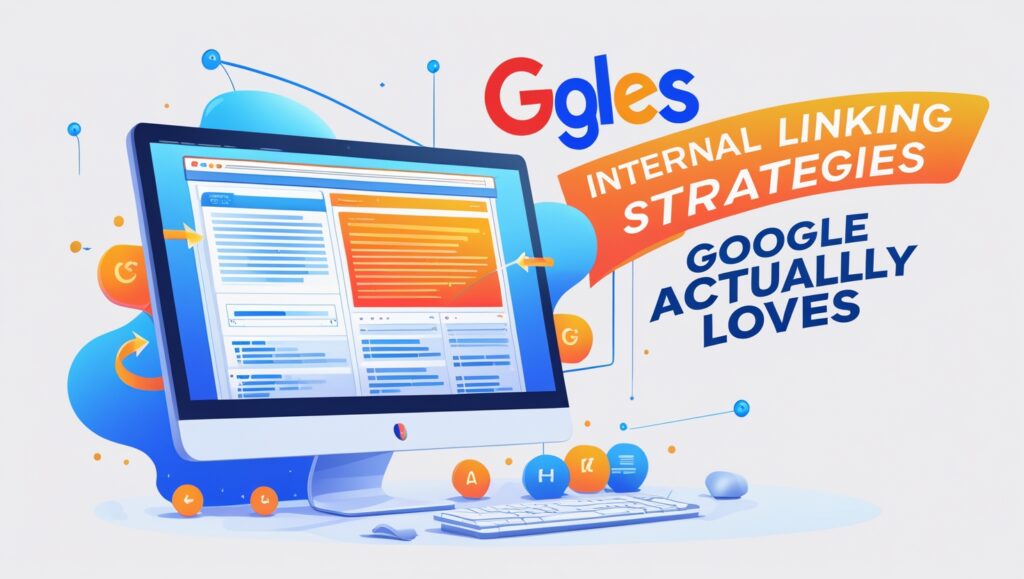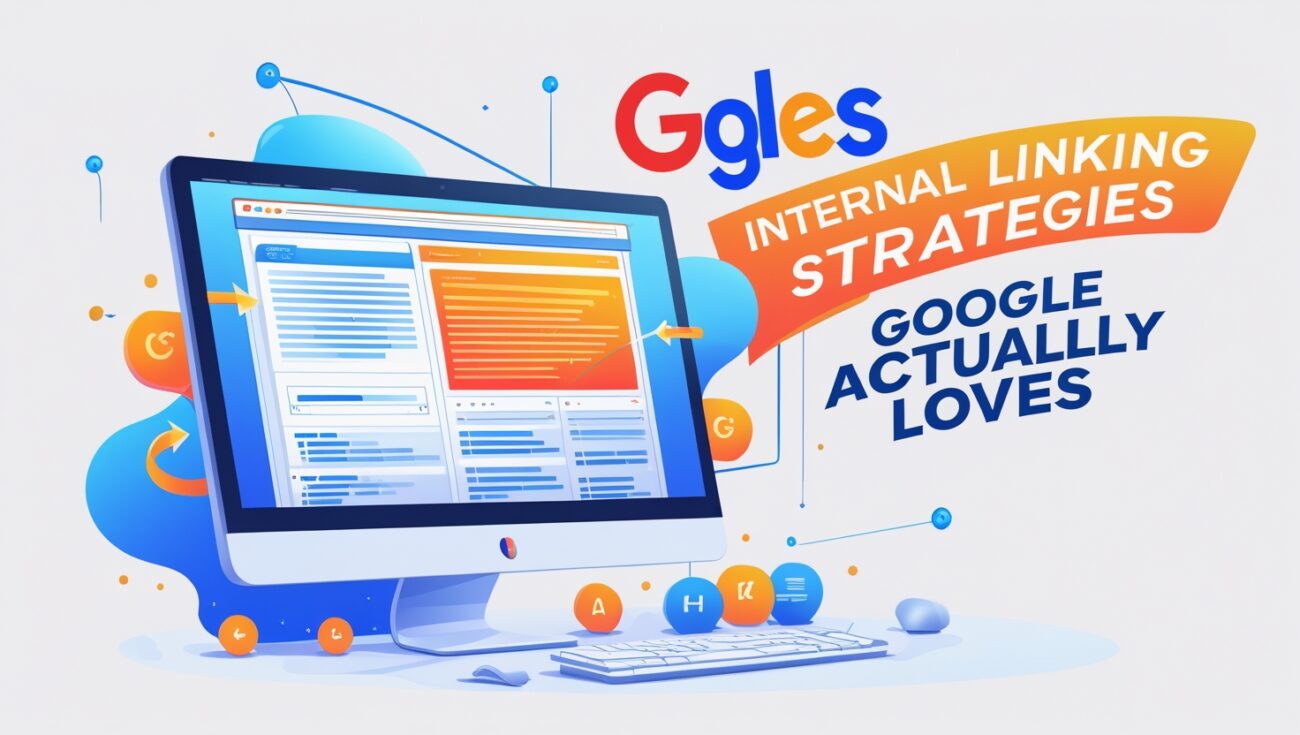Internal Linking Strategies Google Actually Loves
I’ve spent years analyzing what Google’s algorithm rewards, and what I’ve learned is that it’s not about tricking the system. It’s about aligning your website with what Google is trying to achieve: providing the best, most relevant, and most trustworthy results to its users.
While we often focus on things like keywords and backlinks, I’ve found that one of the most powerful and effective strategies is one you have complete control over: internal linking.

Table of Contents
Smart internal linking isn’t just an SEO tactic; it’s a way of structuring your website that makes it naturally more appealing to Google. It’s a win-win: you build a better, more user-friendly site, and in return, you get the ranking boost you’ve been working so hard for. Let me walk you through the core principles and the internal linking strategies that I know for a fact Google’s algorithm is looking for.
The Core Principles Google Cares About
Principle 1: A Great User Experience
Google’s number one goal is to satisfy its users. This means ranking websites that are easy to use, easy to navigate, and feel trustworthy. A visitor who can quickly find what they’re looking for and is guided to relevant, helpful content is a happy user, and Google rewards that kind of positive experience.
Principle 2: Topical Authority
Google wants to rank content from experts, not from generalists. By creating a network of interconnected content, you are demonstrating a deep level of expertise on a broad topic. This is a powerful signal that tells Google you are a go-to authority on a specific subject, making your content a prime candidate for a top ranking.
Principle 3: Crawl Efficiency
Google’s bots have a limited crawl budget for every website. They need to be able to efficiently discover, crawl, and index all of your valuable content. A well-organized, logically structured website with a clear internal linking profile makes it easy for bots to do their job, ensuring that all of your hard work gets noticed.
Internal Linking Strategies That Align with Google’s Goals
Strategy 1: The Hub-and-Spoke Model
This is the ultimate strategy for demonstrating topical authority. Create a comprehensive “hub” or “pillar” page that covers a broad topic in detail. Then, write several “spoke” articles that go into more depth on specific sub-topics. Finally, link from your hub to all of your spokes, and from your spokes back to your hub. This creates a clear topical cluster that Google absolutely loves.
Strategy 2: Contextual and Relevant Linking
Google doesn’t just want a bunch of links; it wants links that add value. The links you create should be placed naturally within the body of your content and should provide a clear, logical next step for the user. A link from an article about “how to bake bread” to a page about “the best bread baking pans” is a relevant, helpful link that Google’s algorithm will favor.
Strategy 3: Rescuing Orphaned and Low-Authority Pages
Google wants to find all of your valuable content. An orphaned page is a page with no incoming internal links, making it invisible to search engine crawlers. By finding and fixing these pages, and by strategically passing link equity from your high-authority pages to your low-authority ones, you are helping Google fulfill its mission of discovering all of your valuable content. I highly recommend using a tool like Linkbot to easily find all of your orphaned and low-authority pages.
The Role of Automation in Pleasing Google
Manually implementing these strategies is incredibly time-consuming and difficult. How can you be sure you’re finding every relevant linking opportunity? How do you know which pages are your high-authority hubs and which are the low-authority ones that need a boost? Automated internal linking software can analyze your website and provide you with a prioritized, actionable list of linking opportunities. It’s the most efficient way to ensure your site is always aligned with what Google wants. With Linkbot, you can automate this crucial part of your SEO.
Conclusion: A Win-Win for You and Google
The best internal linking strategies aren’t about gaming the system. They are about building a better, more organized, and more helpful website for your users. The great thing is, when you do that, you are also building the exact kind of website that Google’s algorithm is designed to reward.
By taking a proactive approach to your internal linking, you are taking control of your SEO and building a foundational asset that will serve you for years to come. Start aligning your internal linking with Google’s goals with Linkbot today.
My journey has taught me that a well-structured site, powered by a smart internal linking strategy, gives your website a strong sense of perceived authority. When a user or a search engine bot lands on your page and sees a clear network of interconnected, relevant articles, it signals that you are a serious, comprehensive resource. This kind of professional organization is exactly what Google looks for when it evaluates a site’s overall trustworthiness.
I also noticed a significant improvement in my website’s crawl efficiency. Before I focused on my internal links, Google’s bots were navigating a scattered collection of pages, often hitting dead ends or getting confused. By creating a clear, logical site architecture with smarter internal links, I made it incredibly efficient for the bots to crawl and index every single page, ensuring none of my valuable content went undiscovered.
The power of a good internal linking strategy is its compounding effect. Each time I publish a new article and strategically link it into my existing hub, I’m making the entire network stronger. It’s a foundational, evergreen tactic that continues to build momentum over time, ensuring the growth I saw wasn’t just a temporary spike. This is what Google loves to see: a site that is continuously improving from the inside out.
I’ll never forget the “Aha!” moment I had when I realized that a lot of my SEO problems were self-inflicted. I was so focused on external factors that I was ignoring the goldmine right under my nose: my own website. By taking control of my internal links, I was finally working on a part of my SEO that I had complete authority over, and the results felt liberating and powerful.
The result of my linking strategy was a dramatic increase in traffic from long-tail keywords. My well-linked pages began ranking for a wider variety of specific search queries, bringing in highly qualified, niche traffic that I wouldn’t have captured otherwise. It was a clear sign that Google was now understanding the full scope of my expertise on a given topic, rewarding my site for its comprehensive nature.
One of the most valuable benefits I got from using an automated tool was the “to-do” list it provided. Instead of being overwhelmed by the sheer size of my website, the tool gave me a prioritized, actionable list of internal links to create. It transformed a monumental, manual task into a series of manageable steps that I could tackle in just minutes, which is exactly what a busy professional needs.
The return on investment for this specific SEO strategy was unlike any other tactic I had tried. Unlike expensive ad campaigns or time-consuming guest-posting efforts, my internal linking overhaul required no external resources. The cost was minimal, and the results were permanent, a significant advantage for any business with a limited budget. This is a win-win for everyone involved.
A consistent linking habit sends a clear signal to Google that your site is well-maintained and cared for. When an algorithm sees that you are regularly updating and connecting your content, it reinforces the idea that your website is a living, breathing resource, which is much more favorable than a stagnant or neglected one.
I’ll never forget the first time I saw a page that had been buried in my site get a huge ranking boost just from a few well-placed links. It was a piece of content I had worked hard on and then forgotten about. This personal experience proved to me that the work I had already done held incredible, untapped value, just waiting to be unlocked.
A clean, logical URL structure works in perfect harmony with your internal links. A clear hierarchy like yourwebsite.com/services/design makes it easy for both users and search engines to understand where they are on your site and what the content is about. This clarity works with your links to signal expertise and build a trustworthy site.
I felt like I was finally in the driver’s seat of my SEO. For years, I had outsourced my link building, which felt like I was giving up control of my SEO destiny. But by mastering my internal links, I was proactively building my site’s authority from the inside out, on my own terms, which was an empowering and exciting feeling.
Ultimately, my journey has shown me that the best SEO strategies are the ones that are aligned with Google’s core mission. By building a better, more organized, and more helpful website with strategic internal links, you are doing exactly what Google wants, and you will be reward

